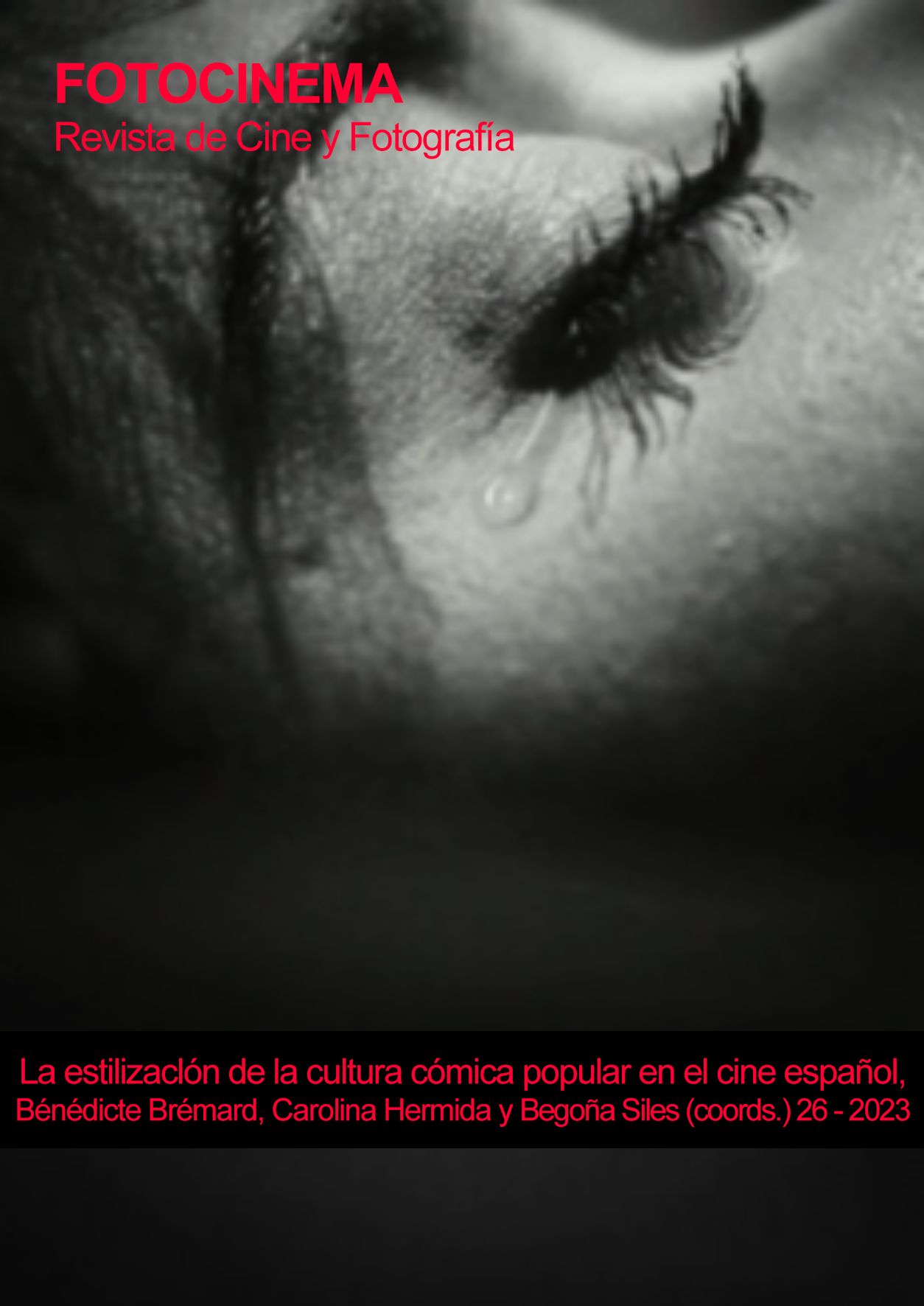Berlanga, Fernán Gómez and the Road to a Popular, Tense and Grotesque Iberian Modernity
DOI:
https://doi.org/10.24310/Fotocinema.2023.vi26.15383Keywords:
Spanish Cinema, Luis García Berlanga, Fernando Fernán Gómez, costumbrism, esperpento, ModernityAbstract
Since the end of the last century, a new historiography, whose methodology is based on film analysis, has revisited Republican Spanish cinema and that of the first post-war decades. This trend constitutes the best starting point to rigorously delve into the deep parallels and intersections of the trajectories of two of the most relevant masters of Hispanic cinema: Luis García Berlanga and Fernando Fernán Gómez. According to that, this article analyzes the determined but difficult career path undertaken by both authors from the sainete (starting from the comic "slightly curved mirror" by Wenceslao Fernández Flórez) to the grotesque (with the extreme concavity of the vallenclanesco Callejón del Gato in their great films of early 1960s). In this trajectory, the literary works of Carlos Arniches and the aforementioned Fernández Flórez will constitute some of the pillars on which a fertile Hispanic and everyday realism will be built; a comic, dark and truthful realism about the miserability of the life of the por Spanish people, bringing to light the scourges and secular backwardness of our country.
Downloads
Metrics
Publication Facts
Reviewer profiles N/A
Author statements
Indexed in
-
—
- Academic society
- N/A
- Publisher
- Universidad de Málaga
References
Anónimo (1960). Entrevista a Berlanga (1960) TeleRadio, nº 147 (17-23 de octubre).
Castro de Paz, José Luis & Cerdán, Josetxo (2011). Del sainete al esperpento. Relecturas del cine español de los años 50. Madrid: Cátedra.
Castro de Paz, José Luis (2010). Fernando Fernán-Gómez. Madrid: Cátedra.
Castro de Paz, José Luis (2012). Sombras desoladas. Costumbrismo, humor, melancolía y reflexividad en el cine español de los años cuarenta (1939-1950). Santander: Shangrila.
Castro de Paz, J. L. & Zunzunegui, S. (2021). Furia española. Vida, obra, opiniones y milagros de Luis García Berlanga (1921-2010). Madrid y Valencia: Filmoteca Española,
Fernández Flórez, W. (1921). El espejo irónico. Madrid: Biblioteca nueva.
Fernán Gómez, F. (1995) Prólogo a El anacoreta (de Rafael Azcona y Juan Estelrich)”, recogido en Desde la última fila. Cien años de cine. Madrid: Espasa-Calpe.
Fernán Gómez, F. (1998). El tiempo amarillo. Barcelona: Península.
Font, Doménec (1978). A propósito de Escopeta nacional. Sobre un misal franquista y los pelos del pubis. La mirada nº 4 (octubre), pp. 15-16.
García de Dueñas, J. (2001). Entrevista a Fernando Fernán Gómez con motivo de la concesión de la Medalla de Oro de la Academia de las Artes y las Ciencias Cinematográficas de España.
González Requena, J. (1984). El cuerpo del actor. En Pérez Perucha. El cine de José Isbert. Valencia: Ayuntamiento de Valencia, pp. 37-38.
Guarner, J. L. (1981). Notas sobre el concepto de espacio en el cine de Berlanga. En Pérez Perucha, J. Berlanga 2, Valencia: Ayuntamiento de Valencia, 1981, pp. 42-43.
Hernández Ruiz, J. & Pérez Rubio, P. (1993). Un universo proteico y multiforme: La comedia costumbrista del desarrollismo. En VV. AA. El paso del mudo al sonoro en el cine español. Actas del IV Congreso de la A.E.H.C. Madrid: Complutense/A.E.H.C., pp. 311-320.
Hoppewell, J. (1989). El cine español después de Franco. Madrid: El Arquero.
Martínez Sierra, G. (1928). Hablando con Valle-Inclán de él y su obra, ABC (7 de diciembre).
Pena, J. (2005). Berlanga 1954-1957: Y de la ternura ¿qué? En Castro de Paz, J.L & Pérez Perucha, J. (coords.) (2005): La atalaya en la tormenta. El cine de Luis García Berlanga. Ourense: X Festival Internacional de Cine Independiente, pp. 41-48.
Pérez Perucha, J. (ed.) (1984). El cine de José Isbert. Valencia: Ayuntamiento de Valencia.
Pérez Perucha, J. (2005). Un desconocido trabajo de Berlanga. En Castro de Paz, J.L. & Pérez Perucha, J. (coords.) (2005): La atalaya en la tormenta. El cine de Luis García Berlanga. Ourense: X Festival Internacional de Cine Independiente, pp. 163-170.
Sánchez Biosca, V. (1989). Fotografía y puesta en escena en el cine español de los años 1940-50. En Llinás, F. (coord.). Directores de fotografía del cine español. Madrid: Filmoteca Española, pp. 57-79.
Téllez, J. L. (1984). La eternidad dispersa. En El cine de José Isbert. Valencia: Ayuntamiento de Valencia, pp. 41-43.
Zunzunegui, S. (1993). El cuerpo y la máscara. Para una tipología del actor español: el caso de Alfredo Landa. En VV. AA. El paso del mudo al sonoro. Actas del IV Congreso de la Asociación Española de Historiadores del Cine. Madrid: Complutense, pp. 207-213.
Downloads
Published
How to Cite
Issue
Section
License
All contents published in Fotocinema Revista científica de cine y fotografía are protected under the Creative Commons Attribution-NonCommercial-ShareAlike 4.0 International (CC BY-NC-SA 4.0) license. All about this license is available in the following link: <http://creativecommons.org/licenses/by-nc-sa/4.0>
Users can copy, use, redistribute, share and exhibit publicly as long as:
- The original source and authorship of the material are cited (Journal, Publisher and URL of the work).
- It is not used for comercial purposes.
- The existence of the license and its especifications are mentioned.
There are two sets of authors’ rights: moral and property rights. Moral rights are perpetual prerogatives, unrenounceable, not-transferable, unalienable, imprescriptible and inembargable. According to authors’ rights legislation, Fotocinema. Revista científica de cine y fotografía recognizes and respects authors moral rights, as well as the ownership of property rights, which will be transferred to University of Malaga in open access. The property rights are referred to the benefits that are gained by the use or the dissemination of works. Fotocinema. Revista científica de cine y fotografía is published in an open access form and it is exclusively licenced by any means for doing or authorising distribution, dissemination, reproduction, , adaptation, translation or arrangement of works.
Authors are responsable for obtaining the necessary permission to use copyrighted images.














13.png)



